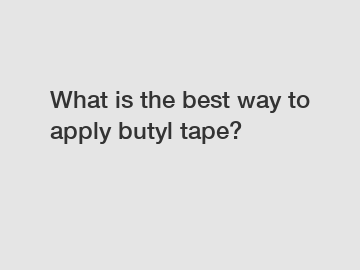What is the best way to apply butyl tape?
Welcome fellow DIY enthusiasts and professionals to our comprehensive guide on the best way to apply Butyl Tape, specifically the remarkable Pipeline Butyl Rubber Joint Tape! Are you ready to unleash your creativity and achieve a flawless pipe joint seal? We're here to guide you through the process step-by-step, ensuring a successful application every time. Let's dive in!
What Makes Pipeline Butyl Rubber Joint Tape Unique?
First, let's understand why Pipeline Butyl Rubber Joint Tape stands out among its competitors. This exceptional tape is specifically designed for seamless pipe joint sealing, providing robust protection against leaks, corrosion, and climate elements. Its butyl rubber composition offers unrivaled bonding strength and flexibility, ensuring durable and long-lasting results for both indoor and outdoor applications.

Step 1: Surface Preparation for Optimal Adhesion.
Before applying the Pipeline Butyl Rubber Joint Tape, it's crucial to prepare surfaces properly. Begin by thoroughly cleaning, degreasing, and drying the pipe joint area. This ensures optimal adhesion and creates an ideal surface for the tape to bond with. Remember, a clean surface is a key to success!
Step 2: Temperature Considerations for Tape Application.
Pipeline Butyl Rubber Joint Tape is designed to perform flawlessly across a wide temperature range. However, it's always wise to consider the environmental conditions during application. Work in temperatures between 40°F and 90°F (4°C and 32°C) for the best results. Extreme temperatures may affect the tape's pliability and bonding capabilities.
Step 3: Measuring and Cutting with Precision.
To achieve a professional finish, it's crucial to measure and cut the Pipeline Butyl Rubber Joint Tape with precision. Evaluate the circumference of the pipe joint and estimate the required tape length accordingly. Use a sharp utility knife or shears to cut the tape, ensuring straight, clean edges for even application.
Step 4: Unleashing the Power of Pipeline Butyl Rubber Joint Tape.
With the previous steps completed, it's time to let the magic happen! Begin by peeling off the protective backing gradually, exposing the adhesive side of the tape. Align the tape along the pipe joint while applying even pressure to ensure a secure bond. The remarkable flexibility of the Pipeline Butyl Rubber Joint Tape enables easy conformity to irregular surfaces, enhancing its unparalleled sealing capabilities.
Step 5: Sealing the Deal with Proper Overlapping.
For ultimate protection against water ingress and other factors, overlap the Pipeline Butyl Rubber Joint Tape by a minimum of 50% to create a robust seal. Carefully press down on the overlapping sections, ensuring full adhesion between the layers. Be thorough in this step to avoid any potential leaks or weak spots.
Step 6: Final Touches and Quality Assurance.
Congratulations, you're almost there! Use a roller or your hand to apply consistent pressure along the entire length of the applied tape. This extra step helps to ensure optimal bonding and remove any trapped air bubbles. Double-check that all edges are securely adhered, leaving no room for potential water intrusion.
Conclusion:
There you have it, the ultimate guide to applying Pipeline Butyl Rubber Joint Tape creatively, efficiently, and effectively. Seamlessly seal your pipe joints with this remarkable tape, providing durability, longevity, and unmatched protection. Incorporating these outlined steps and embracing your creative side, you'll embark on a successful journey towards perfectly sealed pipe joints. Remember, the best way to apply butyl tape is with careful preparation, precision, and the exceptional Pipeline Butyl Rubber Joint Tape by your side!
For more information, please visit pipe wrapping tape manufacturers, Visco Elastic Coating Tape, visco elastic pipe coating manufacturer.
234
0
0


Comments
All Comments (0)